
🎬 个人主页 :艾莉丝努力练剑
❄专栏传送门 :《C语言》《数据结构与算法》《C/C++干货分享&学习过程记录》
《Linux操作系统编程详解》《笔试/面试常见算法:从基础到进阶》《Python干货分享》
⭐️为天地立心,为生民立命,为往圣继绝学,为万世开太平
🎬 艾莉丝的简介:

🎬 艾莉丝的C++专栏简介:

文章目录
- C++学习阶段的三个参考文档
- [4 ~> 可变参数模版](#4 ~> 可变参数模版)
-
- [4.5 emplace系列接口](#4.5 emplace系列接口)
-
- [4.5.1 不同容器emplace系列接口展示](#4.5.1 不同容器emplace系列接口展示)
- [4.5.2 浅谈emplace系列接口概念](#4.5.2 浅谈emplace系列接口概念)
- [4.5.3 emplace系列接口在list.h文件中的使用](#4.5.3 emplace系列接口在list.h文件中的使用)
- [4.5.4 emplace系列接口在Test.cpp文件中的使用](#4.5.4 emplace系列接口在Test.cpp文件中的使用)
- [4.5.5 万能引用](#4.5.5 万能引用)
- [5 ~> 新的类功能](#5 ~> 新的类功能)
-
- [5.1 默认成员函数:默认移动构造和移动赋值](#5.1 默认成员函数:默认移动构造和移动赋值)
- [5.2 成员函数声明时要给缺省值](#5.2 成员函数声明时要给缺省值)
- [5.3 defult和delete](#5.3 defult和delete)
-
- [5.3.1 概念](#5.3.1 概念)
- [5.3.2 最佳实践](#5.3.2 最佳实践)
- [5.4 目标构造函数和委托构造函数(了解)](#5.4 目标构造函数和委托构造函数(了解))
-
- [5.4.1 目标构造函数](#5.4.1 目标构造函数)
- [5.4.2 委托构造函数](#5.4.2 委托构造函数)
- [5.4.3 最佳实践](#5.4.3 最佳实践)
- [5.5 final和override](#5.5 final和override)
- [6 ~> C++11:STL的变化](#6 ~> C++11:STL的变化)
-
- [6.1 新的容器](#6.1 新的容器)
- [6.2 新的接口](#6.2 新的接口)
- [6.3 宝藏:范围for](#6.3 宝藏:范围for)
- [7 ~> lambta](#7 ~> lambta)
-
- [7.1 lambta表达式的语法](#7.1 lambta表达式的语法)
-
- [7.1.1 概念](#7.1.1 概念)
- [7.1.2 最佳实践](#7.1.2 最佳实践)
- [7.2 lambta的应用场景](#7.2 lambta的应用场景)
-
- [7.2.1 说明](#7.2.1 说明)
- [7.2.2 最佳实践](#7.2.2 最佳实践)
- [7.3 捕捉列表(*)](#7.3 捕捉列表(*))
-
- [7.3.1 概念](#7.3.1 概念)
- [7.3.2 最佳实践](#7.3.2 最佳实践)
- [7.4 lambta的原理](#7.4 lambta的原理)
-
- [7.4.1 原理](#7.4.1 原理)
- [7.4.2 最佳实践](#7.4.2 最佳实践)
- [7.4.3 捕捉列表就是仿函数的成员函数](#7.4.3 捕捉列表就是仿函数的成员函数)
- [7.4.4 补充:成员函数中写了lambda](#7.4.4 补充:成员函数中写了lambda)
- C++11完整代码示例与实践演示
- 结尾
C++学习阶段的三个参考文档
看库文件(非官方文档): Cplusplus.com
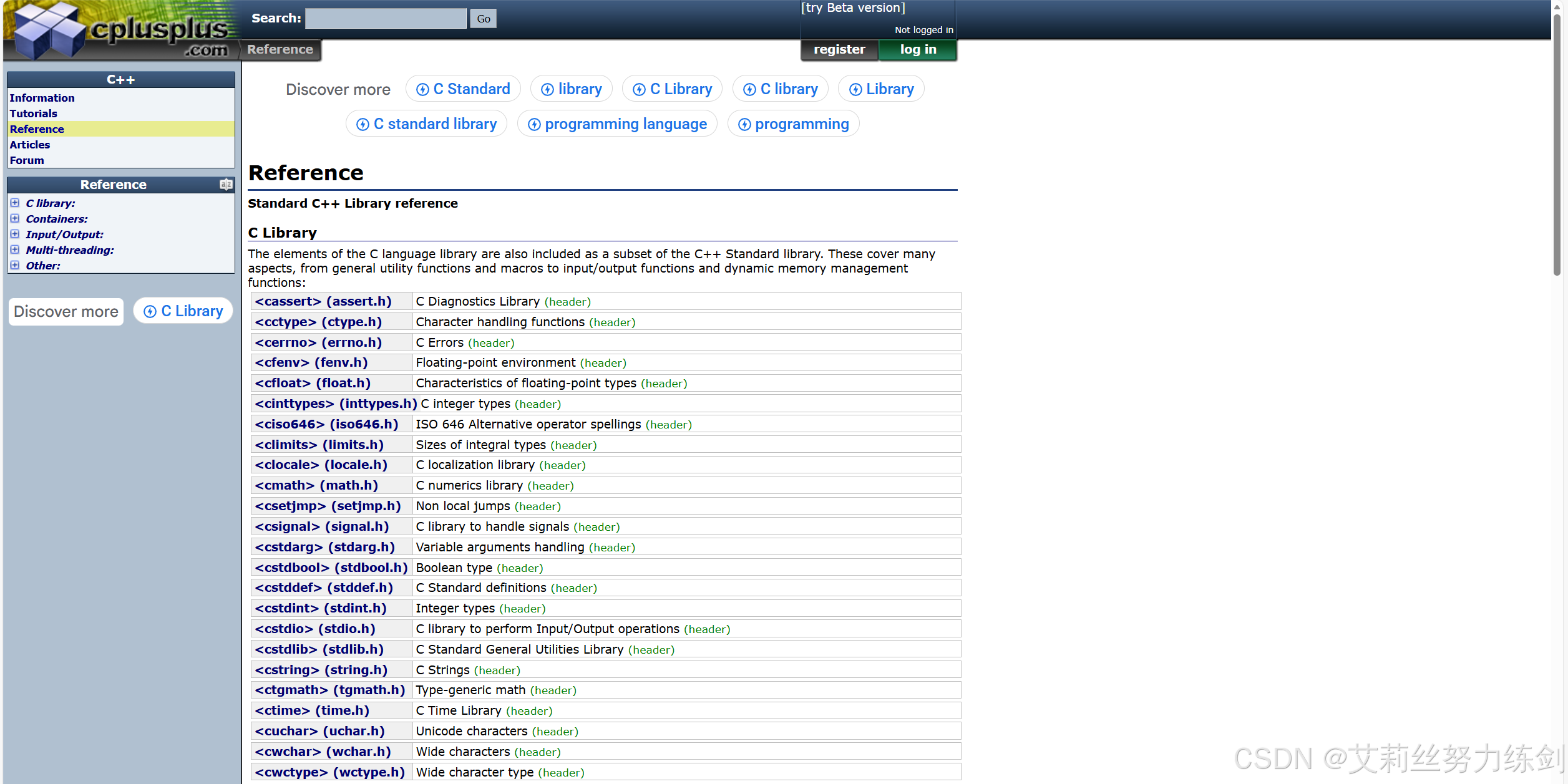
这个文档在C++98、C++11时候还行,之后就完全没法用了......
准官方文档(同步更新) ------还 可以看语法 :C++准官方参考文档

这个行,包括C++26都同步了,我们以后主要会看这个。
官方文档(类似论坛): Standard C++

这个网站上面会有很多大佬,类似于论坛。

4 ~> 可变参数模版
4.5 emplace系列接口
4.5.1 不同容器emplace系列接口展示






4.5.2 浅谈emplace系列接口概念
cpp
template <class..· Args> void emplace_back(Args&&... args);
cpp
template <class...Args> iterator emplace (const_iterator position,Args&&...args);C++11以后STL容器新增了empalce系列的接口,empalce系列的接口均为模板可变参数,功能上兼容push和insert系列,但是empalce还支持新玩法,假设容器为container,empalce还支持直接插入构造T对象的参数,这样有些场景会更高效一些,可以直接在容器空间上构造T对象。
emplace_back总体而言是更高效,推荐以后使用emplace系列替代insert和push系列(也不是完全被淘汰了),只是说建议之后用emplace_back替代替代insert和push系列,push_back效率其实也不差,传参数包那种emplace_back效率才有优势,传右值传左值两者效率其实是差不多的,传string参数包有区别------push_back要先移动构造再构造,emplace_back直接构造------一步到位。



如下图,我们模拟实现了list的emplace和emplace_back接口,这里把参数包不段往下传递,最终在结点的构造中直接去匹配容器存储的数据类型T的构造,所以达到了前面说的empalce支持直接插入构造T对象的参数,这样有些场景会更高效一些,可以直接在容器空间上构造T对象。
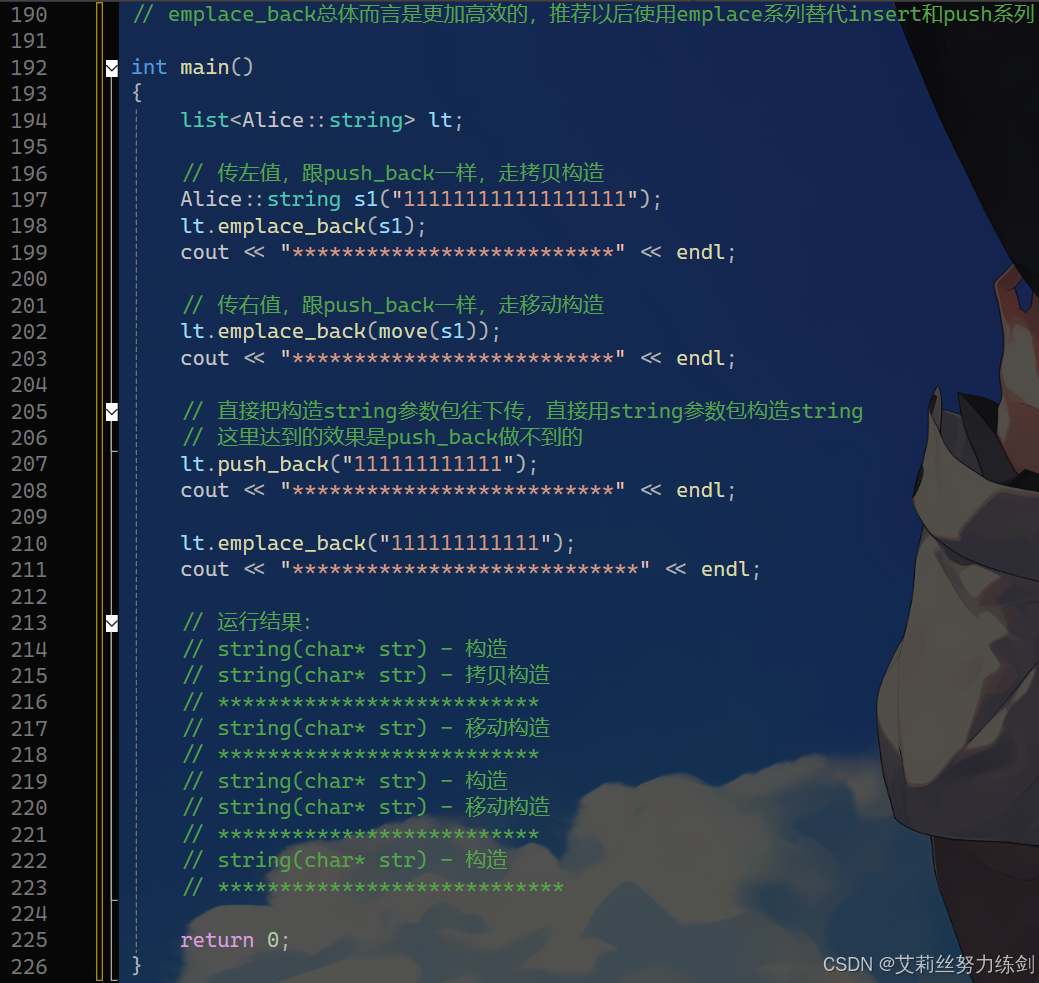
传递参数包过程中,如果是Args&&... args的参数包,要用完美转发参数包,方式如下std::forward<Args>(args) ...,否则编译时包扩展后右值引用变量表达式就变成了左值。
4.5.3 emplace系列接口在list.h文件中的使用

4.5.4 emplace系列接口在Test.cpp文件中的使用

4.5.5 万能引用


5 ~> 新的类功能
5.1 默认成员函数:默认移动构造和移动赋值
原来C++类中,有6个默认成员函数:构造函数 / 析构函数 / 拷贝构造函数 / 拷贝赋值重载 / 取地址重载 / const取地址重载 ,最后重要的是前4个,后两个用处不大(介绍类和对象时也没怎么提),默认成员函数就是我们不写编译器会生成一个默认的 。C++11新增了两个默认成员函数:移动构造函数和移动赋值运算符重载。
条件苛刻: 如果你没有自己实现移动构造函数,且没有实现析构函数、拷贝构造、拷贝赋值重载中的任意一个。那么编译器会自动生成一个默认移动构造。默认生成的移动构造函数,对于内置类型成员会执行逐成员按字节拷贝,自定义类型成员,则需要看这个成员是否实现移动构造,如果实现了就调用移动构造,没有实现就调用拷贝构造。

如果你没有自己实现移动赋值重载函数,且没有实现析构函数、拷贝构造、拷贝赋值重载中的任意一个,那么编译器会自动生成一个默认移动赋值。默认生成的移动构造函数,对于内置类型成员会执行逐成员按字节赋值,自定义类型成员,则需要看这个成员是否实现移动赋值,如果实现了就调用移动赋值,没有实现就调用拷贝赋值。(默认移动赋值跟上面移动构造完全类似)

如果你提供了移动构造或者移动赋值,编译器不会自动提供拷贝构造和拷贝赋值。

5.2 成员函数声明时要给缺省值
成员变量声明时给的缺省值(类内成员初始化)会在构造函数的初始化阶段使用。具体来说:如果某个成员变量没有在初始化列表中显式初始化,编译器会自动在初始化列表中使用这个缺省值来初始化它;如果该成员在初始化列表中被显式初始化了,那么显式初始化的值会覆盖声明时的缺省值,这个我们在类和对象部分介绍过了------
往期回顾: 【类和对象(下)】C++类与对象的进阶艺术:初始化列表到性能优化的完全指南
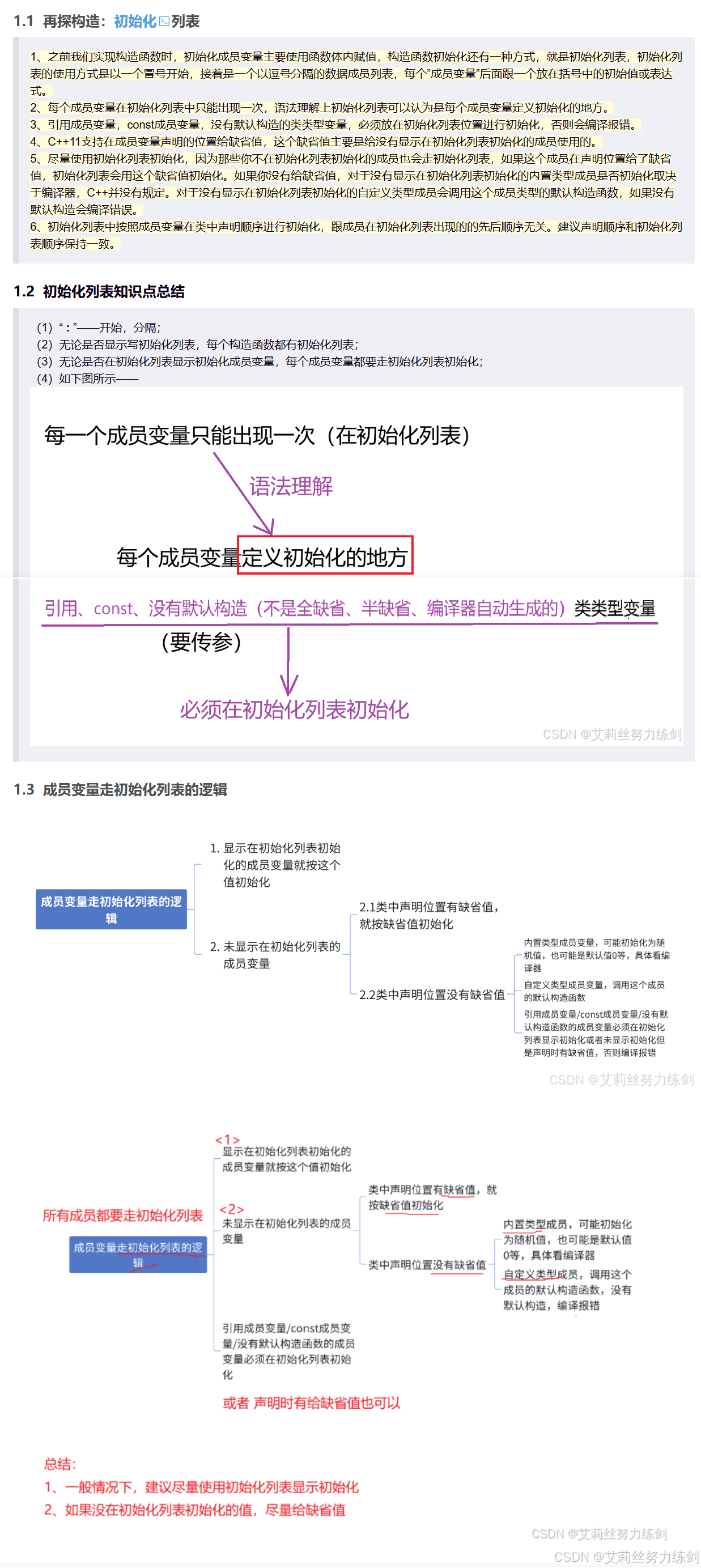
5.3 defult和delete
5.3.1 概念
C++11可以让你更好的控制要使用的默认函数。假设你要使用某个默认的函数,但是因为一些原因这个函数没有默认生成。比如:我们提供了拷贝构造,就不会生成移动构造了,那么我们可以使用default关键字显示指定移动构造生成。
如果能想要限制某些默认函数的生成,在C++98中,是该函数设置成private(私有),并且 只声明不实现 ,这样只要其他人想要调用就会报错。在C++11中更简单,只需在该函数声明加上【 = delete】即可,该语法指示编译器不生成对应函数的默认版本,称【= delete】修饰的函数为 删除函数。
5.3.2 最佳实践
如下图所示------
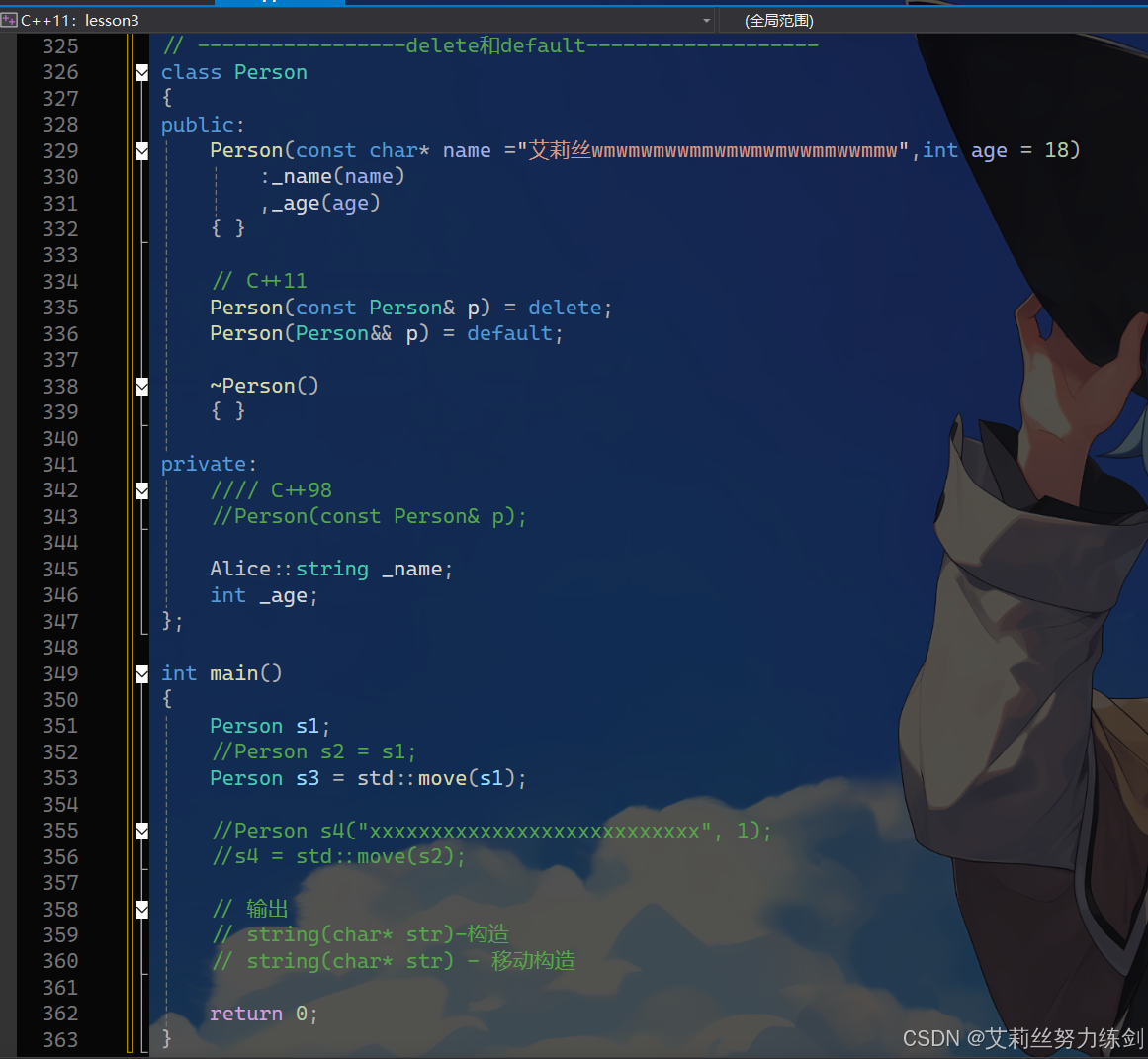
5.4 目标构造函数和委托构造函数(了解)
5.4.1 目标构造函数
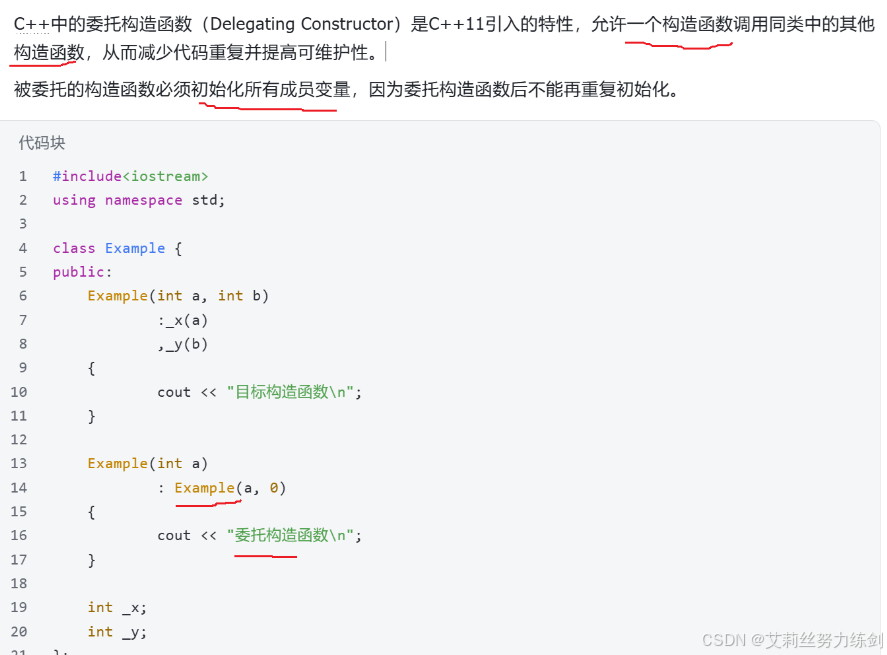
5.4.2 委托构造函数

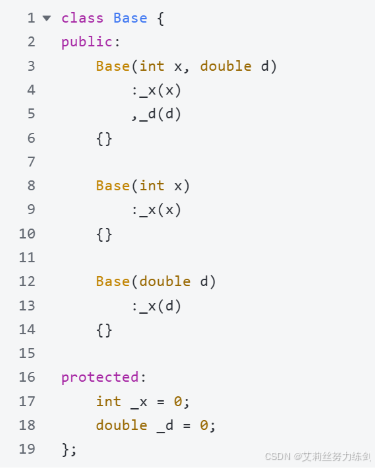
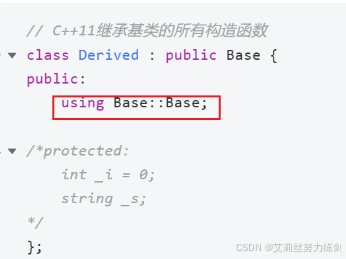
5.4.3 最佳实践
这两个函数了解即可,艾莉丝给uu们简单演示了一下------
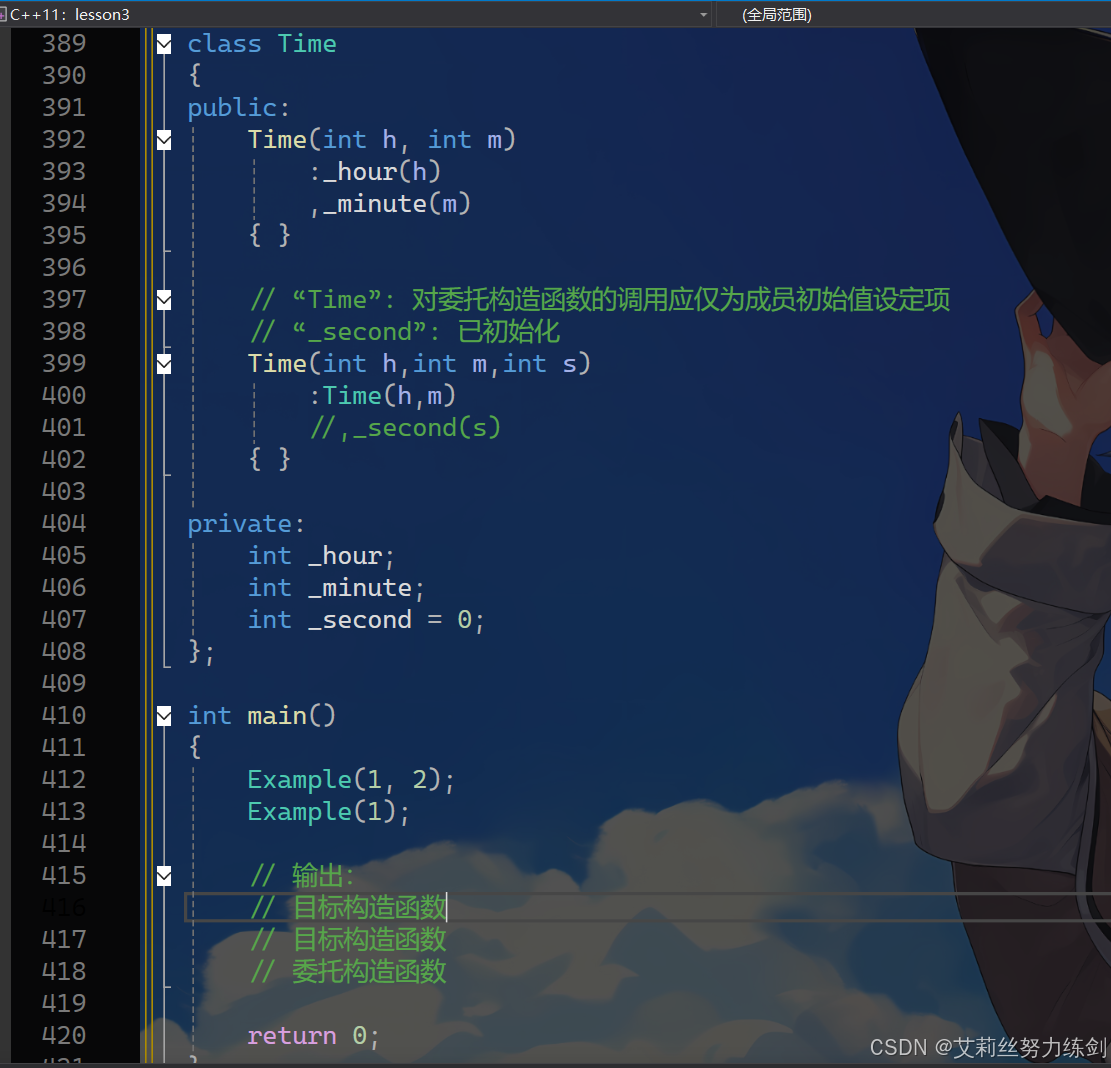
5.5 final和override
老朋友,这个final和override我们在继承和多态那个章节已经进行了详细讲过了,uu们如果忘了就看一下艾莉丝往期的博客------
【C++:继承】C++面向对象继承全面解析:派生类构造、多继承、菱形虚拟继承与设计模式实践
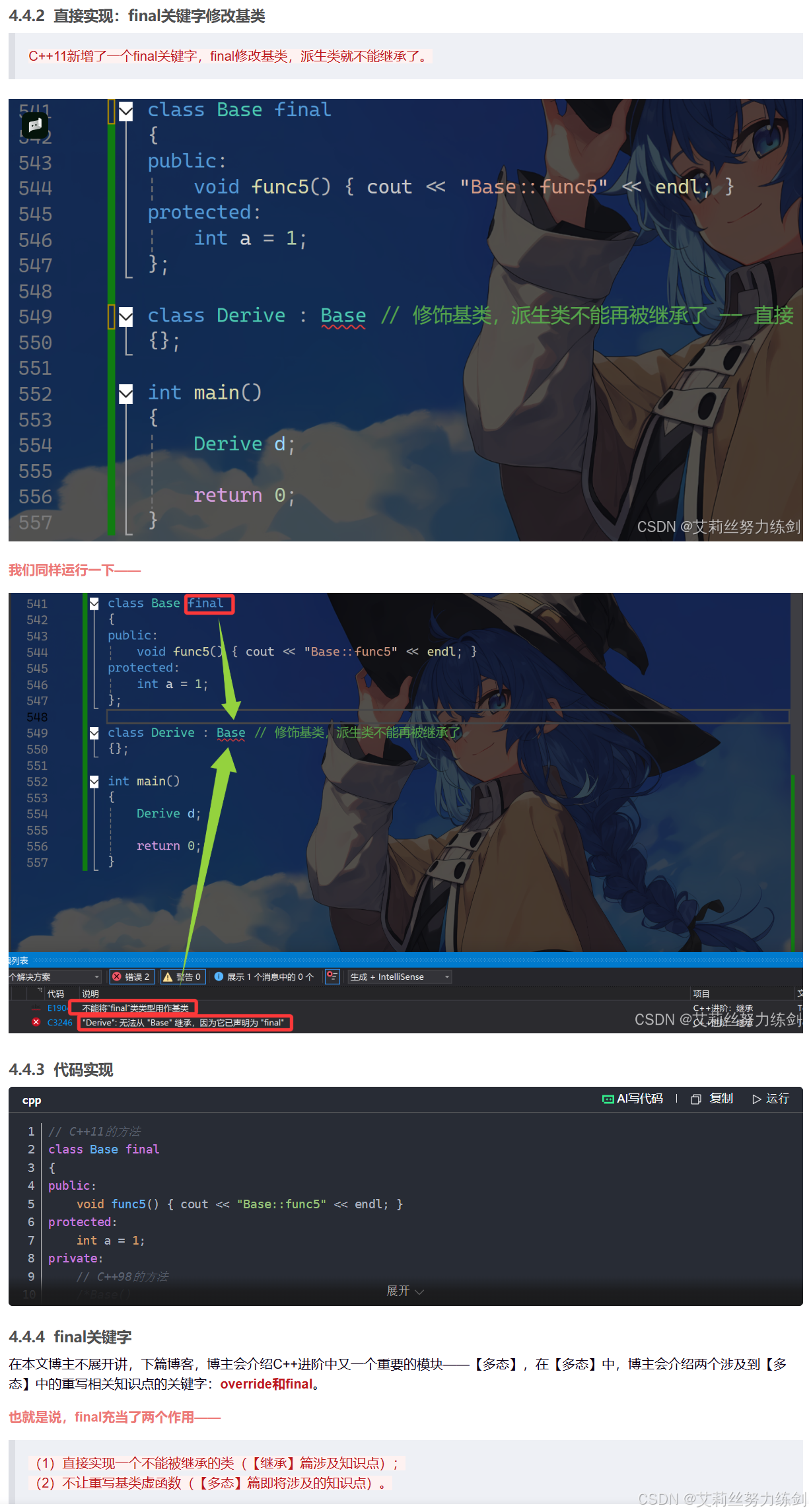
【C++:多态】C++多态实现深度剖析:从抽象类约束到虚函数表机制

这里艾莉丝重新展示一下关于final和override艾莉丝画的思维导图------

6 ~> C++11:STL的变化
6.1 新的容器
下面这张图中圈起来的就是 C++11的STL中的新增容器 ,但是实际中最有用的是**unordered_map和unordered_set**。
C++11新增容器:array、forward_list(单链表)、unordered_map和unordered_ed(真正有用的就这俩)------

这两个我们前面已经进行了非常详细的介绍,其他的大家了解一下即可,艾莉丝这里再把介绍两个容器的博客链接放在这里------
【C++:unordered_set和unordered_map】C++无序容器深度解析:unordered_set和unordered_map的使用
6.2 新的接口
STL中容器的新接口也不少,最重要的就是右值引用和移动语义相关的push / insert / emplace系列接口 (插入数据系列的接口 );移动构造和移动赋值 (雪中送炭),还有initializer_list版本的构造(锦上添花的作用)等,这些前面都讲过了,还有一些无关痛痒的cbegin / cend等需要时查查文档即可(文档链接放在开头)。
6.3 宝藏:范围for
容器的范围for遍历,这个在容器部分也讲过了,这里艾莉丝把链接挂在下面了------
【C++:map和set的使用】C++ map/multimap完全指南:从红黑树原理入门到高频算法实战
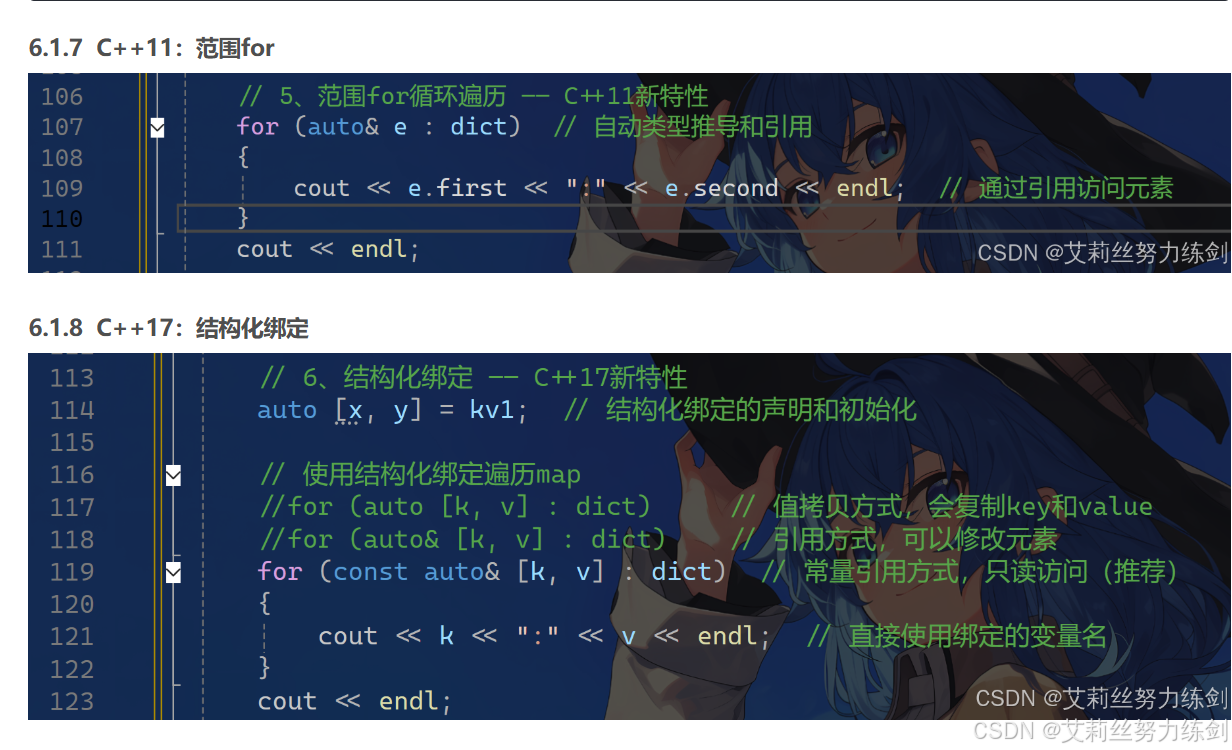
7 ~> lambta
7.1 lambta表达式的语法

7.1.1 概念
lambda表达式本质是一个匿名函数对象 ,跟普通函数不同的是:lambta表达式可以定义在函数内部。
lambda表达式语法使用层而言没有类型,所以我们一般是用auto或者模板参数定义的对象去接收lambda对象。
lambda表达式的格式:
cpp
[capture-list](parameters)->return type{function boby }[ capture-list ]:捕捉列表,该列表总是出现在lambda函数的开始位置,编译器根据[]来判断接下来的代码是否为lambda函数,捕捉列表能够捕捉上下文中的变量供lambda函数使用,捕捉列表可以传值和传引用捕捉,具体细节在下面介绍捕捉列表的部分再细嗦。捕捉列表为空也不能省略。
( parameters ) :参数列表,与普通函数的参数列表功能类似,如果不需要参数传递,则可以连同()一起省略
->returntype:返回值类型,用追踪返回类型形式声明函数的返回值类型,没有返回值时此部分可省略。一般返回值类型明确情况下,也可省略,由编译器对返回类型进行推导。
{functionboby}:函数体,函数体内的实现跟普通函数完全类似,在该函数体内,除了可以使用其参数外,还可以使用所有捕获到的变量,函数体为空也不能省略。

7.1.2 最佳实践
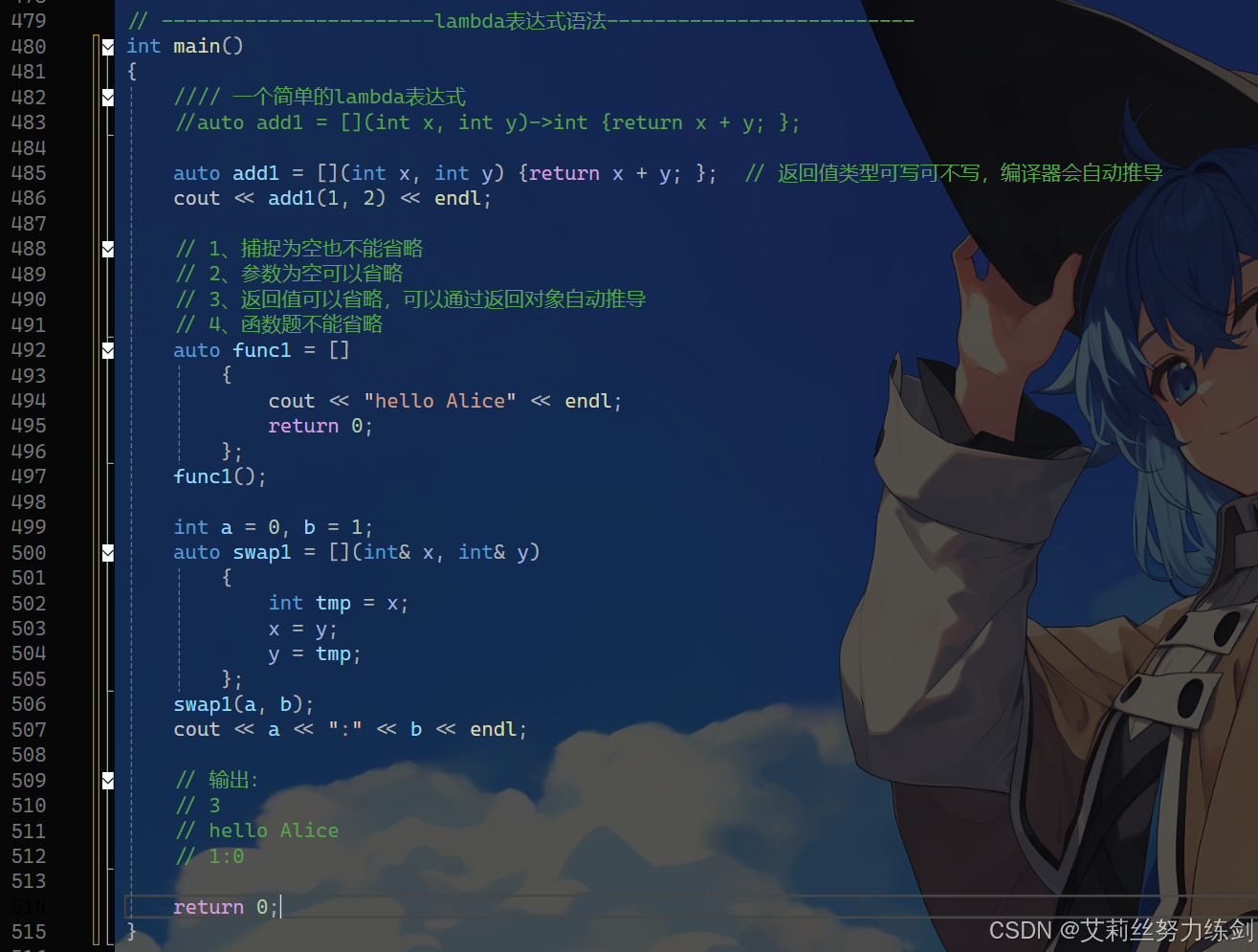
7.2 lambta的应用场景
7.2.1 说明
在介绍 lambda 表达式之前,我们的使用的可调用对象只有函数指针和仿函数对象,函数指针的类型定义起来比较麻烦,仿函数要定义一个类,相对会比较麻烦。使用lambda去定义可调用对象,既简单又方便。
lambda 在很多其他地方用起来也很好用。比如线程中定义线程的执行函数逻辑,智能指针中定制删除器等, lambda 的应用还是很广泛的,以后我们会不断接触到,主要这个是一个我们之前没有接触过的新知识点,uu们要留意一下哦!
7.2.2 最佳实践
cpp
struct Goods
{
string _name; // 名字
double _price; // 价格
int _evaluate; // 评价
// ...
Goods(const char* str,double price,int evaluate)
:_name(str)
,_price(price)
,_evaluate(evaluate)
{ }
};
struct ComparePriceLess
{
bool operator()(const Goods& gl, const Goods& gr)
{
return gl._price < gr._price;
}
};
struct ComparePriceGreater
{
bool operator()(const Goods& gl, const Goods& gr)
{
return gl._price > gr._price;
}
};
struct CompareEvaluateGreater
{
bool operator()(const Goods& gl, const Goods& gr)
{
return gl._evaluate < gr._evaluate;
}
};
struct CompareEvaluateLess
{
bool operator()(const Goods& gl, const Goods& gr)
{
return gl._evaluate < gr._evaluate;
}
};
int main()
{
vector<Goods> v = { { "苹果", 2.1, 5 }, { "香蕉", 3, 4 }, { "橙子", 2.2, 3}, { "菠萝", 1.5, 4 } };
// 类似这样的场景,我们实现仿函数对象或者函数指针支持商品中
// 不同项的比较,相对还是比较麻烦的,那么这里lambda就很好用了
//sort(v.begin(), v.end(), ComparePriceLess());
//sort(v.begin(), v.end(), ComparePriceGreater());
//sort(v.begin(), v.end(), CompareEvaluateLess());
//sort(v.begin(), v.end(), CompareEvaluateGreater());
//auto priceLess = [](const Goods& gl, const Goods& gr)
// {
// return gl._price < gr._price;
// };
//sort(v.begin(), v.end(), priceLess);
sort(v.begin(), v.end(), [](const Goods& gl, const Goods& gr) {
return gl._price < gr._price;
});
sort(v.begin(), v.end(), [](const Goods& gl, const Goods& gr) {
return gl._price > gr._price;
});
sort(v.begin(), v.end(), [](const Goods& gl, const Goods& gr) {
return gl._evaluate < gr._evaluate;
});
sort(v.begin(), v.end(), [](const Goods& gl, const Goods& gr) {
return gl._evaluate > gr._evaluate;
});
return 0;
}大家应该注意到了被注释掉的代码段其实就是用到了我们的lambda表达式,这四个比较的仿函数,用lambda表达式只要一段代码就能完成,这就是lambda表达式,非常的方便。艾莉丝会在原理部分详细介绍一下------其实lambda原理和同样是C++11更新的内容------范围for------的原理很类似,这里的"很像"不是指lambda的原理也是底层被替换成迭代器(lambda的底层是一个operator(),编译器会帮你生成一个仿函数,)这里我们说的"很像",指的是lambda和范围for都是编译器帮你生成!
7.3 捕捉列表(*)
7.3.1 概念
lambda 表达式中默认只能用 lambda 函数体和参数中的变量,如果想用外层作用域中的变量就需要进行捕捉
第一种捕捉方式 是在捕捉列表中显示的传值捕捉和传引用捕捉,捕捉的多个变量用逗号分割。[x,y,&z]表示x和y是值捕捉,z是引用捕捉。
第二种捕捉方式 是在捕捉列表中隐式捕捉,我们在捕捉列表写一个=表示隐式值捕捉,在捕捉列表写一个&表示隐式引用捕捉,这样我们 lambda 表达式中用了那些变量,编译器就会自动捕捉那些变量。
第三种捕捉方式 是在捕捉列表中混合使用隐式捕捉和显示捕捉。[=,&X表示其他变量隐式值捕捉,x引用捕捉;[&,X,y表示其他变量引用捕捉,x和y值捕捉。当使用混合捕捉时,第一个元素必须是& 或 =,并且&混合捕捉时,后面的捕捉变量必须是值捕捉,同理=混合捕捉时,后面的捕捉变量必须是引用捕捉。
lambda 表达式如果在函数局部域中,他可以捕捉 lambda 位置之前定义的变量,不能捕捉静态局部变量和全局变量,静态局部变量和全局变量也不需要捕捉, lambda 表达式中可以直接使用。这也意味着 lambda 表达式如果定义在全局位置,捕捉列表必须为空。
默认情况下, lambda 捕捉列表是被const修饰的,也就是说传值捕捉的过来的对象不能修改,mutable加在参数列表的后面可以取消其常量性,也就说使用该修饰符后,传值捕捉的对象就可以修改了,但是修改还是形参对象,不会影响实参。使用该修饰符后,参数列表不可省略(即使参数为空)。
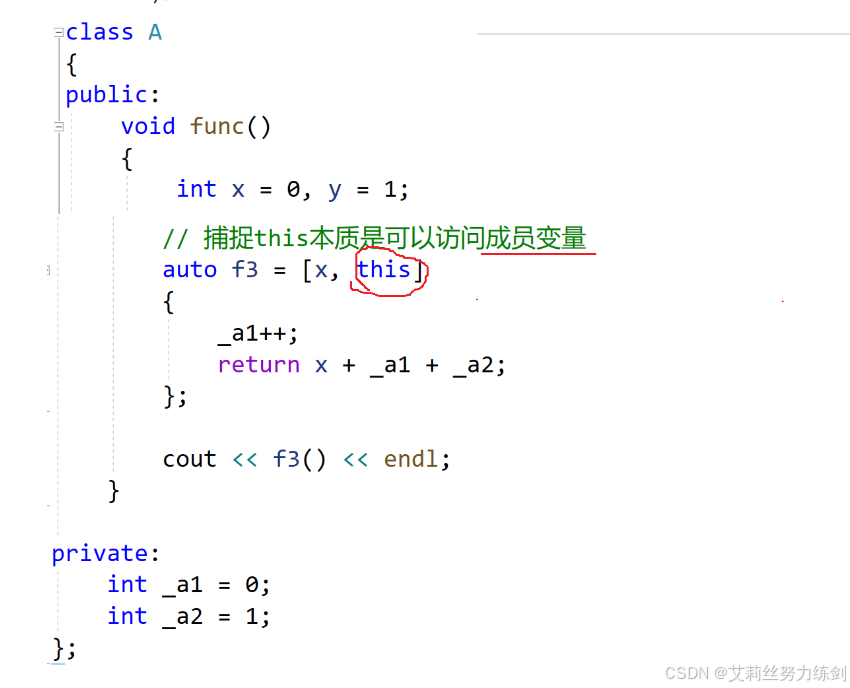
7.3.2 最佳实践
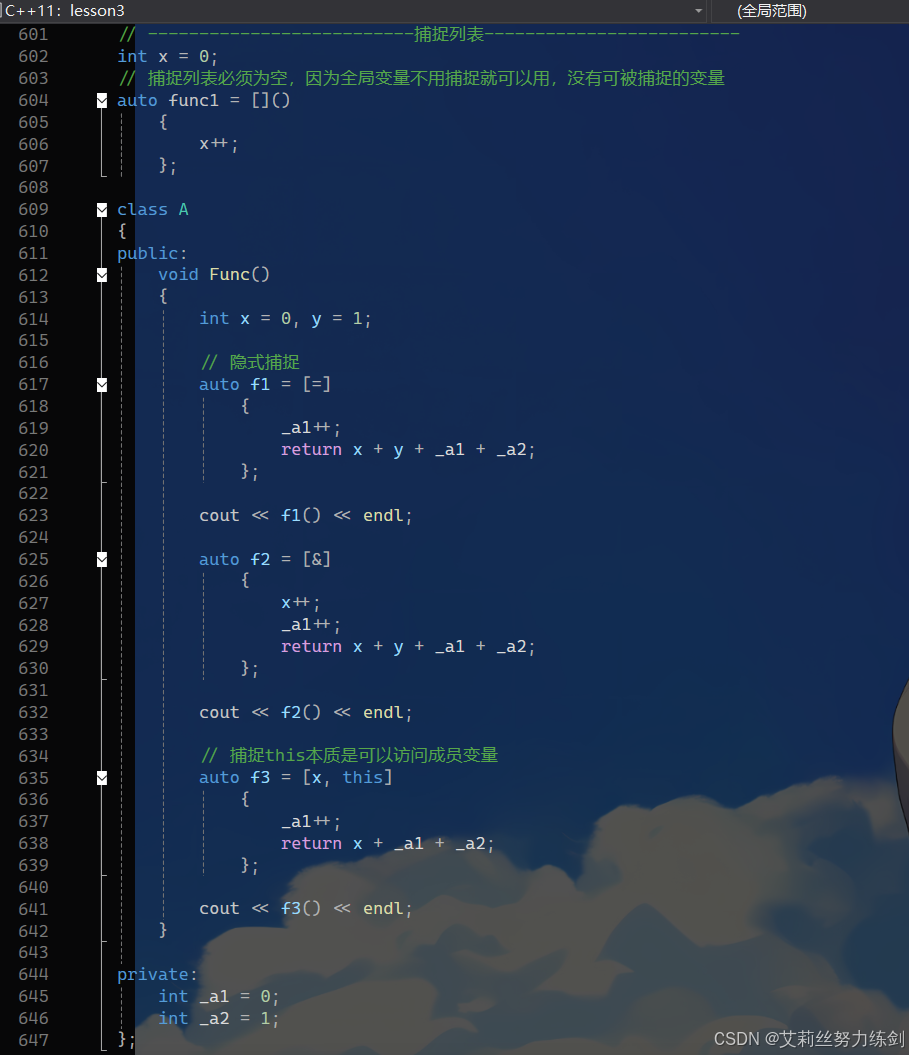
看一下main函数------

7.4 lambta的原理
7.4.1 原理
lambda的原理和范围for很像,编译后从汇编指令层的角度看,压根就没有lambda和范围for这样的东西。范围for底层是迭代器,而lambda底层是仿函数对象,也就说我们写了一个lambda以后,编译器会生成一个对应的仿函数的类。
仿函数的类名是编译按一定规则生成的,保证不同的lambda生成的类名不同,lambda参数 / 返回类型 / 函数体就是仿函数operator()的参数/返回类型/函数体 ,lambda的捕捉列表本质是生成的仿函数类的成员变量------也就是说捕捉列表的变量都是lambda类构造函数的实参,当然隐式捕捉不同,编译器也不是傻瓜,实际上,编译器看使用哪些就传哪些对象。
7.4.2 最佳实践
我们实践一下------

语法层拿不到lambda的类型,不是说没有类型,而是我们拿不到,但是编译器能够拿到。
简而言之,如下图所示------

7.4.3 捕捉列表就是仿函数的成员函数
捕捉列表就是仿函数的成员函数------

7.4.4 补充:成员函数中写了lambda
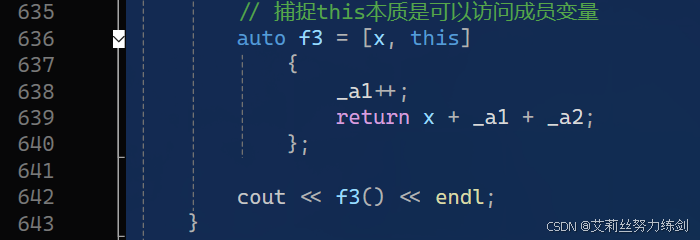
也可以修改成员变量,这里this捕捉的本质是lambda可以访问成员变量。
注意:局部的静态变量和全局的全局变量,不用也不能捕捉(两者的生命周期在全局)!
C++11完整代码示例与实践演示
list.h:
cpp
#pragma once
namespace jqj
{
// --------------链表节点结构--------------
template<class T>
struct list_node
{
list_node<T>* _next; // 指向下一个节点的指针
list_node<T>* _prev; // 指向前一个节点的指针
T _data; // 节点存储的数据
// --------------节点构造函数--------------
list_node(const T& x = T())
:_next(nullptr)
, _prev(nullptr)
, _data(x) // x 节点数据,默认为T类型的默认值
{}
};
// --------------链表迭代器--------------
// 实现双向迭代器功能,支持前向和后向遍历
template<class T, class Ref,class Ptr> // T 数据类型
// Ref 引用类型(T& 或 const T&)
struct list_iterator
{
// using还具有tepedef没有的功能
// 使用类型别名(C++11新特性)
using Self = list_iterator<T, Ref, Ptr>; // 自身类型
using Node = list_node<T>; // 节点类型
Node* _node; // 当前指向的节点指针
// 迭代器构造函数
list_iterator(Node* node)
:_node(node)
{}
// 迭代器解引用操作
// *it = 1
// Ref 返回节点数据的引用(可读或可写)
Ref operator*() // 解引用,Ref就是reference,引用的意思
{
return _node->_data;
}
// operator*()返回对应数据类型的引用
Ptr operator->() // 返回对应数据类型的指针
{
return &_node->_data;
}
// ++it
// 前向迭代操作
Self& operator++() // Self& 返回递增后的迭代器引用
{
_node = _node->_next;
return *this;
}
Self operator++(int) // Self 返回递增前的迭代器副本
{
Self tmp(*this);
_node = _node->_next;
return tmp;
}
// --it
// 后向迭代操作
Self& operator--() // Self& 返回递减后的迭代器引用
{
_node = _node->_prev;
return *this;
}
Self operator--(int) // Self 返回递减前的迭代器副本
{
Self tmp(*this);
_node = _node->_prev;
return tmp;
}
// 迭代器比较操作
bool operator!=(const Self& s) const // bool 两个迭代器是否不指向同一节点
{
return _node != s._node;
}
bool operator==(const Self& s) const // bool 两个迭代器是否不指向同一节点
{
return _node == s._node;
}
};
//template<class T>
//struct list_const_literator
//{
// using Self = list_const_literator<T>;
// using Node = list_node<T>; Node* _node;
// Node* _node;
// list_const_iterator(Node* node)
// :_node(node)
// { }
// // *it
// const T& operator*()
// {
// return _node->_data;;
// }
// // ++it
// Self& operator++()
// {
// _node = _node->_next;
// return *this;
// }
// Self operator++(int)
// {
// Self tmp(*this);
// _node = _node->_next;
// return *this;
// }
// // --it
// Self& operator--()
// {
// _node = _node->_prev;
// return *this;
// }
// Self operator--(int)
// {
// Self tmp(*this);
// _node = _node->_prev;
// return tmp;
// }
// bool operator!=(const Self& s) const
// {
// return _node != s._node;
// }
// bool operator==(const Self& s) const
// {
// return _node == s._node;
// }
//};
// --------------链表主体类--------------
template<class T>
class list
{
using Node = list_node<T>; // 节点类型别名
public:
// 迭代器类型定义
using iterator = list_iterator<T, T&, T*>; // 普通迭代器
using const_iterator = list_iterator<T, const T&, const T*>; // 常量迭代器
// const T* 只能读数据,不能修改数据
//using iterator = list_iterator<T>;
//using const_iterator = list_const_iterator<T>;
// --------------迭代器访问接口--------------
// 获取指向第一个元素的迭代器
// iterator 指向首元素的迭代器
iterator begin()
{
return iterator(_head->_next);
}
// iterator 指向哨兵节点的迭代器
iterator end()
{
return iterator(_head);
}
// 获取指向第一个元素的常量迭代器
// const_iterator 指向首元素的常量迭代器
const_iterator begin() const
{
return const_iterator(_head->_next);
}
// const_iterator 指向哨兵节点的常量迭代器
const_iterator end() const
{
return const_iterator(_head);
}
// ----------------链表初始化相关-----------------
void empty_init() // 初始化空链表(创建哨兵节点)
{
_head = new Node;
_head->_next = _head;
_head->_prev = _head;
}
// 默认构造函数
list()
{
empty_init();
}
// 初始化列表构造函数
// il 初始化列表
list(initializer_list<T> il)
{
empty_init();
for (auto& e : il)
{
push_back(e);
}
}
// 范围构造函数
// InputIterator 输入迭代器类型
template <class InputIterator>
list(InputIterator first, InputIterator last) // first 范围起始迭代器 // last 范围结束迭代器
{
empty_init();
while (first != last)
{
push_back(*first);
++first;
}
}
// 数量构造函数(size_t版本)
list(size_t n, T val = T()) // val 元素值,默认为T的默认值
{
empty_init();
for (size_t i = 0; i < n; ++i)
{
push_back(val);
}
}
// 数量构造函数(int版本)
list(int n, T val = T()) // val 元素值,默认为T的默认值
{
empty_init();
for (size_t i = 0; i < n; ++i)
{
push_back(val);
}
}
// -------------析构函数-------------
// 清理所有节点并释放哨兵节点
~list()
{
clear();
delete _head;
_head = nullptr;
_size = 0;
}
// -----------拷贝控制函数----------
// lt 要拷贝的源链表
// ------------传统写法------------
// lt2(lt1)
list(const list<T>& lt)
{
empty_init();
for (auto& e : lt)
{
push_back(e);
}
}
// 拷贝赋值运算符
// lt 要拷贝的源链表
// list<T>& 返回当前链表的引用
// lt1 = lt3
list<T>& operator=(const list<T>& lt)
{
if (this != <)
{
clear();
for (auto& e : lt)
{
push_back(e);
}
}
return *this;
}
////------------现代写法------------
//list(list<T>& lt)
// list(const list& lt)
//{
// empty_init();
// list tmp(lt.begin(), lt.end());
// swap(tmp);
//}
//// lt1 = lt3
////list<T>& operator=(list<T> tmp)
//list& operator=(list tmp)
//{
// swap(tmp);
//}
// ----------------容量操作---------------
// 交换两个链表的内容
void swap(list<T>& lt) // lt 要交换的另一个链表
{
std::swap(_head, lt._head);
std::swap(_size, lt._size);
}
// 清空链表中的所有元素
// 保留哨兵节点,删除所有数据节点
void clear()
{
iterator it = begin();
while (it != end())
{
it = erase(it);
}
}
template<class... Args>
void emplace_back(Args&&... args)
{
emplace(end(), args...);
emplace(end(), forward<Args>(args)...);
}
template<class ...Args>
void emplace(iterator pos, Args&&...args)
{
Node* cur = pos._node;
Node* prev = cur->_prev;
Node* newnode = new Node(forward<Args>(args)...);
// prev newnode cur
prev->_next = newnode;
newnode->_prev = prev;
newnode->_next = cur;
cur->_prev = newnode;
++_size;
}
void push_back(T&& x)
{
insert(end(), forward<T>(x));
}
// 在链表头部插入元素,x:要插入的元素值
void push_front(const T& x)
{
insert(begin(), x);
}
// 删除链表尾部元素
void pop_back()
{
erase(--end());
}
// 删除链表头部元素
void pop_front()
{
erase(begin());
}
void insert(iterator pos, const T& x) // pos:插入位置的迭代器,x:要插入的元素值
{
Node* cur = pos._node;
Node* prev = cur->_prev;
Node* newnode = new Node(x);
// // 连接新节点:prev -> newnode -> cur
// prev newnode cur
prev->_next = newnode;
newnode->_prev = prev;
newnode->_next = cur;
cur->_prev = newnode;
++_size;
}
void insert(iterator pos, T&& x) // pos:插入位置的迭代器,x:要插入的元素值
{
Node* cur = pos._node;
Node* prev = cur->_prev;
Node* newnode = new Node(move(x));
// // 连接新节点:prev -> newnode -> cur
// prev newnode cur
prev->_next = newnode;
newnode->_prev = prev;
newnode->_next = cur;
cur->_prev = newnode;
++_size;
}
// 删除指定位置的元素
iterator erase(iterator pos) // iterator 返回指向被删除元素后一个元素的迭代器
{
Node* cur = pos._node;
Node* prev = cur->_prev;
Node* next = cur->_next;
// 跳过被删除节点:prev -> next
prev->_next = next;
next->_prev = prev;
delete cur;
--_size;
/*return iterator(next);*/
return next; /// 返回下一个节点的迭代器
//两种写法都可以
}
// -------------- 容量信息 ------------------
size_t size() const
{
//size_t n = 0;
//for (auch e : *this)
//{
// ++n;
//}
//return n;
return _size;
}
private:
Node* _head; // 哨兵头节点指针
size_t _size = 0; // 链表元素个数计数器
};
}Test.cpp:
cpp
#define _CRT_SECURE_NO_WARNINGS 1
#include<iostream>
#include<vector>
#include<map>
#include<list>
#include<string>
using namespace std;
#include<assert.h>
#include<algorithm>
namespace Alice
{
class string
{
public:
typedef char* iterator;
typedef const char* const_iterator;
iterator begin()
{
return _str;
}
iterator end()
{
return _str + _size;
}
const_iterator begin() const
{
return _str;
}
const_iterator end() const
{
return _str + _size;
}
string(const char* str = "")
:_size(strlen(str))
, _capacity(_size)
{
cout << "string(char* str)-构造" << endl;
_str = new char[_capacity + 1];
strcpy(_str, str);
}
void swap(string& s)
{
std::swap(_str, s._str);
std::swap(_size, s._size);
std::swap(_capacity, s._capacity);
}
// 拷贝构造
string(const string& s)
{
cout << "string(char* str)-拷贝构造" << endl;
reserve(s._capacity);
for (auto ch : s)
{
push_back(ch);
}
}
// 移动构造
string(string&& s)
{
cout << "string(char* str)-移动构造" << endl;
swap(s); // 交换后s持有原对象的资源
} // s析构时会释放原对象的资源,但原对象现在持有什么?
string& operator=(const string& s)
{
cout << "string(char* str)-拷贝赋值" << endl;
if (this != &s)
{
_str[0] = '\0';
_size = 0;
reserve(s._capacity);
for (auto ch : s)
{
push_back(ch);
}
}
return *this;
}
// 移动赋值
string& operator=(string&& s)
{
cout << "string(char* str)-移动赋值" << endl;
swap(s); // 和上面同样的问题
return *this;
}
~string()
{
//cout << "~string() -- 析构" << endl;
delete[] _str;
_str = nullptr;
}
char& operator[](size_t pos)
{
assert(pos < _size);
return _str[pos];
}
void reserve(size_t new_capacity)
{
//int n = 0; // 触发assert的报错机制
if (new_capacity > _capacity)
{
char* tmp = new char[new_capacity + 1];
if (_str)
{
strcpy(tmp, _str); // 包括null终止符
delete[] _str;
}
_str = tmp;
_capacity = new_capacity;
}
}
void push_back(char ch)
{
if (_size >= _capacity)
{
size_t newcapacity = _capacity == 0 ? 4 : _capacity * 2;
reserve(newcapacity);
}
_str[_size] = ch;
++_size;
_str[_size] = '\0';
}
string& operator+=(char ch)
{
push_back(ch);
return *this;
}
const char* c_str() const
{
return _str;
}
size_t size() const
{
return _size;
}
private:
char* _str = nullptr;
size_t _size = 0;
size_t _capacity = 0;
};
// 右值引用和移动语义解决传值返回问题
// 传值返回需要拷贝
string addStrings(string num1, string num2) {
string str;
int end1 = num1.size() - 1, end2 = num2.size() - 1;
// 进位
int next = 0;
while (end1 >= 0 || end2 >= 0)
{
int val1 = end1 >= 0 ? num1[end1--] - '0' : 0;
int val2 = end2 >= 0 ? num2[end2--] - '0' : 0;
int ret = val1 + val2 + next;
next = ret / 10;
ret = ret % 10;
str += ('0' + ret);
}
if (next == 1)
str += '1';
reverse(str.begin(), str.end());
cout << &str << endl;
return str;
}
}
//// emplace_back总体而言是更加高效的,推荐以后使用emplace系列替代insert和push系列
//
//int main()
//{
// list<Alice::string> lt;
//
// // 传左值,跟push_back一样,走拷贝构造
// Alice::string s1("111111111111111111");
// lt.emplace_back(s1);
// cout << "**************************" << endl;
//
// // 传右值,跟push_back一样,走移动构造
// lt.emplace_back(move(s1));
// cout << "**************************" << endl;
//
// // 直接把构造string参数包往下传,直接用string参数包构造string
// // 这里达到的效果是push_back做不到的
// lt.push_back("111111111111");
// cout << "**************************" << endl;
//
// lt.emplace_back("111111111111");
// cout << "****************************" << endl;
//
// // 运行结果:
// // string(char* str) - 构造
// // string(char* str) - 拷贝构造
// // **************************
// // string(char* str) - 移动构造
// // **************************
// // string(char* str) - 构造
// // string(char* str) - 移动构造
// // **************************
// // string(char* str) - 构造
// // ****************************
//
// return 0;
//}
// 日期类
struct Date
{
int _y;
int _m;
int _d;
Date(int year, int month, int day)
: _y(year)
, _m(month)
, _d(day)
{
}
};
//int main()
//{
// list<pair<Alice::string, int>> lt1;
//
// // 跟push_back一样
// // 构造pair + 拷贝/移动构造pair到list的节点中data上
// pair<Alice::string, int> kv("苹果", 1);
// lt1.emplace_back(kv);
// cout << "****************************" << endl;
//
// // 跟push_back一样
// lt1.emplace_back(move(kv));
// cout << "****************************" << endl;
//
// // 直接把构造pair参数包往下传,直接用pair参数包构造pair
// // 这里达到的效果是push_back做不到的
// lt1.emplace_back("苹果", 1);
// //lt1.push_back("苹果", 1); // 错误,要传pair或者{}隐式转换pair的值
// //lt1.push_back({"苹果", 1}); // 要传pair或者{}隐式转换pair的值
// cout << "****************************" << endl;
//
// list<Date> lt;
// // 构造 + 拷贝构造
// Date d1{ 2025,11,18 };
// lt.push_back(d1);
//
// lt.push_back({ 2025, 11, 18 });
//
// // 传构造Date的参数,传给形参参数包,参数包往下不断传递,最后直接构造到链表节点上
// // 直接构造
// lt.emplace_back(2025, 11, 18);
//
// // 运行结果:
// // string(char* str) - 构造
// // string(char* str) - 拷贝构造
// // ****************************
// // string(char* str) - 移动构造
// // ****************************
// // string(char* str) - 构造
// // ****************************
//
// return 0;
//}
//#include"list.h"
//
//int main()
//{
// list<pair<Alice::string, int>> lt1;
// cout << "****************************" << endl;
//
// // 跟push_back一样
// // 构造pair + 拷贝/移动构造pair到list的节点中data上
// pair<Alice::string, int> kv("苹果", 1);
// lt1.emplace_back(kv);
// cout << "****************************" << endl;
//
// // 跟push_back一样
// lt1.emplace_back(move(kv));
// cout << "****************************" << endl;
//
// // 直接把构造pair参数包往下传,直接用pair参数包构造pair
// // 这里达到的效果是push_back做不到的
// lt1.emplace_back("苹果", 1); // 推荐
// //lt1.emplace_back({"苹果", 1}); // 错误
// //lt1.push_back("苹果", 1); // 错误,要传pair或者{}隐式转换pair的值
// //lt1.push_back({"苹果", 1}); // 要传pair或者{}隐式转换pair的值
// cout << "****************************" << endl;
//
// list<Date> lt;
// // 构造 + 拷贝构造
// Date d1{ 2025,11,18 };
// lt.push_back(d1);
// lt.push_back({ 2025, 11, 18 });
//
// // 传构造Date的参数,传给形参参数包,参数包往下不断传递,最后直接构造到链表节点上
// // 直接构造
// lt.emplace_back(2025, 11, 18);
//
// return 0;
//}
//class Person
//{
//public:
// Person(const char* name ="艾莉丝wmwmwmwwmmwmwmwmwwmmwwmmw",int age = 18)
// :_name(name)
// ,_age(age)
// { }
//
// // C++11
// Person(const Person& p) = delete;
// Person(Person&& p) = default;
//
// ~Person()
// { }
//
//private:
// //// C++98
// //Person(const Person& p);
//
// Alice::string _name;
// int _age;
//};
//
//int main()
//{
// Person s1;
// //Person s2 = s1;
// Person s3 = std::move(s1);
//
// //Person s4("xxxxxxxxxxxxxxxxxxxxxxxxxxx", 1);
// //s4 = std::move(s2);
//
// // 输出
// // string(char* str)-构造
// // string(char* str) - 移动构造
//
// return 0;
//}
//#include<iostream>
//using namespace std;
//
//class Example
//{
//public:
// Example(int a,int b)
// :_x(a)
// ,_y(b)
// {
// cout << "目标构造函数\n";
// }
//
// // 委托构造:类似于派生类复用基类
// Example(int a)
// :Example(a,0)
// {
// cout << "委托构造函数\n";
// }
//
// int _x;
// int _y;
//};
//
//class Time
//{
//public:
// Time(int h, int m)
// :_hour(h)
// ,_minute(m)
// { }
//
// // "Time": 对委托构造函数的调用应仅为成员初始值设定项
// // "_second": 已初始化
// Time(int h,int m,int s)
// :Time(h,m)
// //,_second(s)
// { }
//
//private:
// int _hour;
// int _minute;
// int _second = 0;
//};
//
//int main()
//{
// Example(1, 2);
// Example(1);
//
// // 输出:
// // 目标构造函数
// // 目标构造函数
// // 委托构造函数
//
// return 0;
//}
//class Base
//{
//public:
// Base(int x,double d)
// :_x(x)
// ,_d(d)
// { }
//
// Base(int x)
// :_x(x)
// { }
//
// Base(double d)
// :_d(d)
// { }
//
//protected:
// int _x = 0;
// double _d = 0.0;
//};
//
////// 传统的派生类实现构造
////class Dervied :public Base
////{
////public:
//// Dervied(int x):Base(x){}
//// Dervied(double d):Base(d){}
//// Dervied(int x,double d):Base(x,d){}
////};
//
//// C++11继承基类的所有构造函数
//class Dervied :public Base
//{
//public:
// using Base::Base;
//
////protected:
//// int _i = 0;
//// string _s;
//};
//
//// 非常长
//std::map<std::string, std::pair<std::string, std::string>>::iterator func();
//auto func() -> std::map<std::string, std::pair<std::string, std::string>>::iterator;
//
//int main()
//{
// Dervied d1(1);
// Dervied d2(1.1);
// Dervied d3(2,2.2);
//
// return 0;
//}
// ==========================lambda==========================
// -----------------------lambda表达式语法--------------------------
//int main()
//{
// //// 一个简单的lambda表达式
// //auto add1 = [](int x, int y)->int {return x + y; };
//
// auto add1 = [](int x, int y) {return x + y; }; // 返回值类型可写可不写,编译器会自动推导
// cout << add1(1, 2) << endl;
//
// // 1、捕捉为空也不能省略
// // 2、参数为空可以省略
// // 3、返回值可以省略,可以通过返回对象自动推导
// // 4、函数题不能省略
// auto func1 = []
// {
// cout << "hello Alice" << endl;
// return 0;
// };
// func1();
//
// int a = 0, b = 1;
// auto swap1 = [](int& x, int& y)
// {
// int tmp = x;
// x = y;
// y = tmp;
// };
// swap1(a, b);
// cout << a << ":" << b << endl;
//
// // 输出:
// // 3
// // hello Alice
// // 1:0
//
// return 0;
//}
// ---------------------------lambda的应用-------------------------------
//struct Goods
//{
// string _name; // 名字
// double _price; // 价格
// int _evaluate; // 评价
//
// // ...
// Goods(const char* str,double price,int evaluate)
// :_name(str)
// ,_price(price)
// ,_evaluate(evaluate)
// { }
//};
//
//struct ComparePriceLess
//{
// bool operator()(const Goods& gl, const Goods& gr)
// {
// return gl._price < gr._price;
// }
//};
//
//struct ComparePriceGreater
//{
// bool operator()(const Goods& gl, const Goods& gr)
// {
// return gl._price > gr._price;
// }
//};
//
//struct CompareEvaluateGreater
//{
// bool operator()(const Goods& gl, const Goods& gr)
// {
// return gl._evaluate < gr._evaluate;
// }
//};
//
//struct CompareEvaluateLess
//{
// bool operator()(const Goods& gl, const Goods& gr)
// {
// return gl._evaluate < gr._evaluate;
// }
//};
//
//int main()
//{
// vector<Goods> v = { { "苹果", 2.1, 5 }, { "香蕉", 3, 4 }, { "橙子", 2.2, 3}, { "菠萝", 1.5, 4 } };
//
// // 类似这样的场景,我们实现仿函数对象或者函数指针支持商品中
// // 不同项的比较,相对还是比较麻烦的,那么这里lambda就很好用了
//
// //sort(v.begin(), v.end(), ComparePriceLess());
// //sort(v.begin(), v.end(), ComparePriceGreater());
// //sort(v.begin(), v.end(), CompareEvaluateLess());
// //sort(v.begin(), v.end(), CompareEvaluateGreater());
//
// //auto priceLess = [](const Goods& gl, const Goods& gr)
// // {
// // return gl._price < gr._price;
// // };
//
// //sort(v.begin(), v.end(), priceLess);
//
// sort(v.begin(), v.end(), [](const Goods& gl, const Goods& gr) {
// return gl._price < gr._price;
// });
//
// sort(v.begin(), v.end(), [](const Goods& gl, const Goods& gr) {
// return gl._price > gr._price;
// });
//
// sort(v.begin(), v.end(), [](const Goods& gl, const Goods& gr) {
// return gl._evaluate < gr._evaluate;
// });
//
// sort(v.begin(), v.end(), [](const Goods& gl, const Goods& gr) {
// return gl._evaluate > gr._evaluate;
// });
//
// return 0;
//}
// --------------------------捕捉列表-------------------------
int x = 0;
// 捕捉列表必须为空,因为全局变量不用捕捉就可以用,没有可被捕捉的变量
auto func1 = []()
{
x++;
};
class A
{
public:
void Func()
{
int x = 0, y = 1;
// 隐式捕捉
auto f1 = [=]
{
_a1++;
return x + y + _a1 + _a2;
};
cout << f1() << endl;
auto f2 = [&]
{
x++;
_a1++;
return x + y + _a1 + _a2;
};
cout << f2() << endl;
// 捕捉this本质是可以访问成员变量
auto f3 = [x, this]
{
_a1++;
return x + _a1 + _a2;
};
cout << f3() << endl;
}
private:
int _a1 = 0;
int _a2 = 1;
};
int main()
{
// 只能用当前lambda局部域捕捉的对象和全局对象
// 捕获列表的意义,本质更方便的使用当前局部域的对象
int a = 0, b = 1, c = 2, d = 3;
// auto func1=[a,&b] () mutable
auto func1 = [a, &b]
{
// 值捕捉的变量不能修改,引用捕捉的变量可以修改
// a++
b++;
int ret = a + b;
x++;
return ret;
};
cout << func1() << endl;
// 隐式值捕捉
// 用了哪些变量就捕捉哪些变量
auto func2 = [=]
{
int ret = a + b + c;
return ret;
};
cout << func2() << endl;
// 隐式值捕捉
// 用了哪些变量就捕捉哪些变量
auto func3 = [&]
{
a++;
c++;
d++;
};
func3();
cout << a << " " << b << " " << c << " " << d << endl;
// 混合捕捉1
auto func4 = [&,a,b]
{
//a++;
//b++;
c++;
d++;
return a + b + c + d;
};
func4();
cout << a << " " << b << " " << c << " " << d << endl;
// ----------------验证:lambda底层是编译器生成的仿函数(更轻量级的)-------------------
// 仿函数
//class lambda5
//{
//public:
// lambda5(int a_,int b_)
// :a(a_)
// ,b(b_)
// { }
// int operator()(int x)
// {
// ++b;
// return a + b + x;
// }
//private:
// const int a;
// int& b;
//};
//// 运行结果:
//// 2
//// 4
//// 1 2 3 4
//// 1 2 4 5
// lambda
auto func5 = [a, &b](int x)
{
++b;
return a + b + x;
};
// 等价于
// lambda func5(a, b);
func5(1);
//// 运行结果:
//// 2
//// 4
//// 1 2 3 4
//// 1 2 4 5
// 结果完全一样!猜想得到验证!
return 0;
}结尾
uu们,本文的内容到这里就全部结束了,艾莉丝再次感谢您的阅读!
结语:希望对学习C++相关内容的uu有所帮助,不要忘记给博主"一键四连"哦!
往期回顾:
🗡博主在这里放了一只小狗,大家看完了摸摸小狗放松一下吧!🗡 ૮₍ ˶ ˊ ᴥ ˋ˶₎ა
